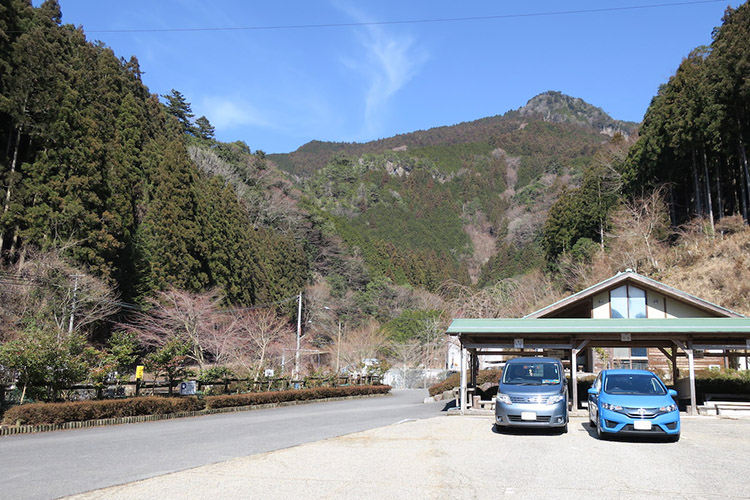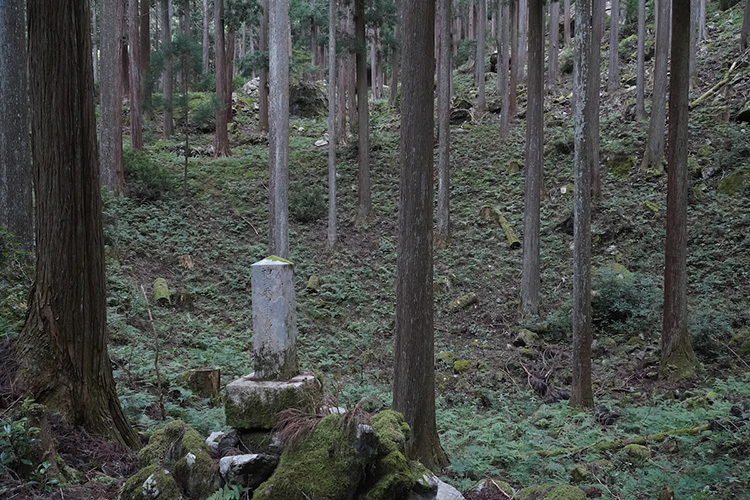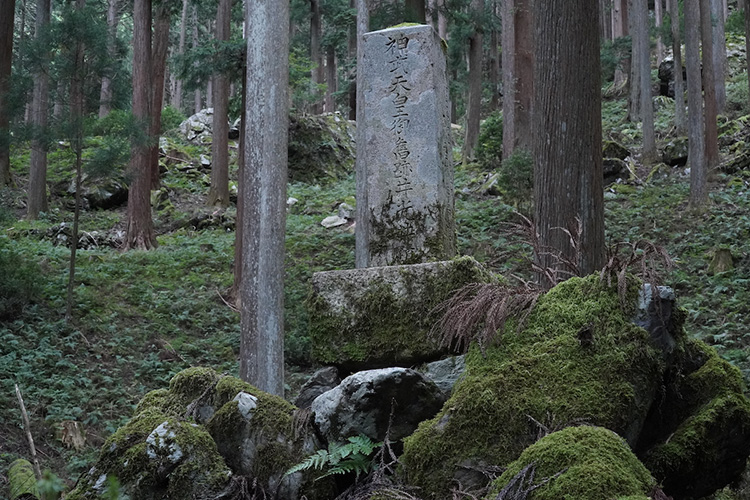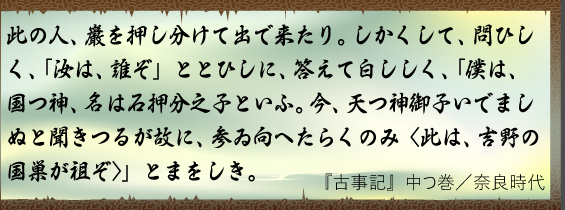2019年11月投稿
posted Nov. 2019

*1
Yatsukarewa, kunitsukami, nawa Ihika to iu
“Kojiki” Nakatsumaki/Nara Period
ー現代語訳ー
私は、国つ神で、名前は井氷鹿といいます
Meaning
I am the local god and my name is Ihika.
『古事記』中つ巻には、川上村・井氷鹿における神武天皇の伝説が記されています。
神武天皇は天照大神の子孫にあたり、『古事記』では「神倭伊波礼毘古命」と呼ばれています。「神聖な倭の伊波礼の男性」という意味です。「伊波礼」は現在の奈良県桜井市周辺の地名といわれています。
“Kojiki” Nakatsumaki has this legend about Emperor Jinmu while he was in Ihika, Kawakami Village.
Emperor Jinmu is one of the descendants of Amaterasu Ookami. In “Kojiki” he is referred as ‘Kamuyamatoiwarebikono Mikoto’. It means a male person in the sacred Iware in Yamato. Iware is said to be the name for Sakurai City and its vicinity.


さて、神倭伊波礼毘古命は、兄の五瀬命と共に、日向の高千穂宮から軍を率いて、天下を治めるためにふさわしい土地を求めて東へ向かいました。瀬戸内海を東行して熊野にまわり、高木大神が遣わした八咫烏に導かれながら、吉野を進みます。
一行の前には、在地の神々が次々と現れ、いずれも恭順の気持ちを表しました。この時、在地の神として現れたのが「井氷鹿」です。井氷鹿の登場は、次のように語られます。
Kamuyamatoiwarebikono Mikoto, along with his older brother Itsuseno Mikoto, headed east from Takachiho in Hyuga looking for a suitable land to rule the nation.They crossed the Seto Inland Sea to Kumano and then to Yoshino, guided by Yaatakarasu, a sacred raven commonly known as Yatagarasu, which Takagino Ookami sent for them.
One by one local gods appeared and promised their loyalty to Emperor Jinmu. Ihika was one of them.

O oitaruhito, iyori idekitari. Sonoini hikari ari. Shikakushite, toishiku, ‘Nanjiwa, tarezo’ to toishini, kotaete moushishiku, ‘Yatsukarewa, kunitsukami, nawa Ihika toiu’ (korewa, yoshinono obitoraga oyazo) to moushiki.
“Kojiki” Nakatsumaki/Nara Period
ー現代語訳ー
井氷鹿の姿は「尾生ひたる人」、つまり「尾」が生えているといいます。出てきたのは「井戸」から。しかも、その井戸は光っているというのです。
神倭伊波礼毘古命は、その人に尋ねました。「お前は、だれか」と。そこで、彼は答えて「私は、国つ神で、名前は井氷鹿といいます」と申し上げました。井氷鹿は、〈吉野首らの祖先である〉とも記されています。
Meaning
Ihika is described here as ‘o oitaruhito ’, meaning he has a tale. He came out from a well and the well was emitting light.
Kamuyamatoiwarebikono Mikoto said to the man, ‘Who are you?’. He replied, ‘I am the local god and my name is Ihika’. Ihika was an ancestor for all heads in the Yoshino region.
この後、神倭伊波礼毘古命は「吉野=吉し野」という名前があらわす通り、吉野の行軍を平穏に果たします。
光る「井戸」から現れ、恭順の意をこめて彼と対峙する井氷鹿の姿は、とても穏やかで、また、とても神秘的です。後に、荒ぶる国つ神々を平定し、初代天皇・神武天皇として即位する神倭伊波礼昆古命の行く末を見守るかのように描かれています。
After this event, Kamuyamatoiwarebikono Mikoto completed his expedition to Yoshino peacefully.
Ihika, appeared out of the bright well and welcomed Kamuyamatoiwarebikono Miko with due allegiance, looked very calm. It was as if he could foresee Kamuyamatoiwarebikono Miko’s success as Emperor Jinmu who managed to win respect from the local gods including himself.


*2
*
ところで、神倭伊波礼毘古命が井氷鹿と出会った場所はどこなのでしょうか。
『古事記』本文では「井戸」から出てきたと記述されていますが、この「井戸」は、現代の「掘り抜き井戸」とは違い、水を汲み取るところを木や石で囲んだ「井筒・井桁」*3とも、「窪地」*4ともいわれています。
The readers may wonder where the place is that Kamuyamatoiwarebikono Mikoto met Ihika.
“Kojiki” describes that he came out of a ‘well’. The well here is not a modern dug well. It is like a basin where pieces of wood and stones were used to surround a water fountain.


川上村・井光地区で「井氷鹿の井戸跡」に比定されている場所を訪れてみました。「井氷鹿の井戸跡」の看板から山の中へ進むと、直径約50m、中心部分の深さ約10mのきれいな円を描く窪地が現れます。鬱蒼と茂ったシダに覆われた大きな窪地の中では、まるで古代からそこにあるかのような巨岩が圧倒的な存在感を放っています。
この、深くしずかな森の中で、神倭伊波礼毘古命は井氷鹿と出会ったと川上村では伝えられています。井氷鹿の井戸跡には、明治三十三年の銘をもつ2つの石碑、「神武天皇御旧跡井光井蹟」と「吉野首部連祖加彌比加尼之墓」が立てられ、井氷鹿伝説を今に伝えています*5。
In the Ihika region in Kawakami Village the writer went to find the spot designated as ‘the remain of Ihika’s Well’. Deep into the mountain from the signboard ‘Ihika’s Well’ is written on, the writer found a sunken circle about 50m diameter and 10m depth in its center. An enormous rock stands magnificently in the circle as if it has been standing there for ages.
In this quiet forest, Kamuyamatoiwarebikono Mikoto was said to have met Ihika and two stone monuments standing there prove the legend. One reads, ‘Remain of Emperor Jinmu’s Shining Well’ and the other ‘Tomb for Yoshino Head Kanehikani’, both erected in 1900.
『古事記』では井氷鹿が姿を現した「井」について、「其の井に光有り」と記し、窪地が光っていたと伝えています。
As “Kojiki” has it that the well Ihika stepped out of ‘is emitting light’.
古代の「光」は、『竹取物語』で「かぐや姫」を描写する際の「光」や、『源氏物語』における光源氏の呼称・「光る君」にみられるように、広い意味では「聖なるもの」を表すと考えていいでしょう*6。神話の「光」も、発生論的には太陽神・日神信仰に基づくと考えらえます。アマテラスにまつわる「天の岩屋戸」のエピソードも、その太陽神的性格を伝えています*7。
The light in the olden times broadly means ‘something sacred’ as in ‘Kaguyahime’ in “Taketori Monogatari” or ‘Hikarunokimi’ in “Genji Monogatari”.
The light in Shinwa, mythology, is also based on the religious belief in Sun God as found in the case of Amaterasu in ‘Amano Iwayado’.


「其の井に光有り」という表現は、この土地が「聖なる空間」であるということを暗示しているのでしょう。「光の表現は、いつの時代にも皇統を荘厳するべく蘇る」*8という解釈もあわせて考えると、光を放つ空間を訪れた神倭伊波礼毘古命は、天皇として即位するにふさわしい方である、という意味を示しているようにも思われます。
なお、「尾生ひたる人」については、「しっぽが生えた人」というよりも、「尾」を「汚れや濡れを防ぐために獣皮を腰にまとった姿」と捉え*9、木こりや狩猟、川魚などの漁労に従事した山の民であるとする説もあります。『古事記』では、在地の人間との出会いを、その服装とともに表現したものと考えられますが、「井戸から出てきたしっぽが生えた人」を現代風に解釈すると、どことなく「ゆるキャラ」のような可愛らしいイメージが漂いますね。
The expression ‘there is light in the well’ supposes that the spot is sacred. There is also an interpretation on the power of light that it ‘revives the solemnity of imperial succession at all times.’ To the writer these point to the suitability of Kamuyamatoiwarebikono Mikoto as an emperor.
As for ‘o oitaru hito’, there is another interpretation that he is a hunter or a logger with a fur to protect himself from getting wet or soiled.
Interpreting it modern way and imagining a man with a tale and coming out of a well, he somehow gives a cute image of ‘yuru chara (a mascot)’ and makes us smile.
『古事記』では、井氷鹿以外に神倭伊波礼毘古命が出会った「国つ神」についても紹介されています。
まずは、八咫烏の先導に従い、吉野川の下流に着いたときの様子です。井氷鹿に出会う前にあたります。
“Kojiki” introduces other gods that Kamuyamatoiwarebikono Mikoto came across.
First, the god he encountered when he arrived the downstream of the River Yoshino guided by Yaatakarasu. The encounter took place before he met Ihika.

Ueo tsukurite uoo toreruhito ari. Shikakushite, Amatsukamimikono toishiku, ‘Nanjiwa tarezo’ to toishini, kotaete moushishiku, ‘Yatsukarewa kunitsukami, nawa Niemotsunoko toiu (korewa adano ukaiga oyazo).
“Kojiki” Nakatsumaki/Nara Period
ー現代語訳ー
筌、つまり、魚を捕らえる仕掛けを作って魚を捕る人がいた。そこで、天つ神である御子・神倭伊波礼毘古命が『お前は誰か』と問うたところ、『私は国つ神で、名は贄持之神といいます』と答えた。〈これは、阿陀の鵜養の祖先である〉
Meaning
There was a man catching fish with ue, a trap. Amatsukamimiko Kamuyamatoiwarebikono Mikoto said to him, “What is your name?” He said, “I am Kunitsukami. My name is Niemotsunoko”. This is the ancestor of Ada’s U-catchers.


阿陀は、『万葉集』に漁業の地として用例がみられる、奈良県五條市阿田周辺に比定されています。
続いて、神倭伊波礼毘古命が井氷鹿との対面後、そのまま山の中を進んでいくと、また尾の生えた人に出会ったといいます。
Ada is identified in “Manyoshu” as the area in Ada, Gojyo City, Nara Prefecture.
Second, another god with a tale. Kamuyamatoiwarebikono Mikoto met him after parting from Ihika.

Konohito, iwaoo oshiwakete idekitari. Shikakushite, toishiku, ‘Nanjiwa tarezo’ to toishini, kotaete moushishiku, ‘Yatsukarewa kunitsukami, nawa Iwaoshiwakunoko toiu. Ima, Amatsukamimiko idemashinuto kikitsuruga yueni, maimukaetarakunomi (korewa yoshinono kunisuga oyazo)’ tomoushiki.
“Kojiki” Nakatsumaki/Nara Period
ー現代語訳ー
この人は、岩を押し分けて出てきた。そこで、神倭伊波礼毘古命が『お前は誰か』と問うたところ、『私は国つ神で、名は石押分之子といいます』と答えた。今、天つ神である御子がいらっしゃったと聞いて、お迎えに参ったのです。〈これは、吉野の国巣の祖先である〉
Meaning
This man came out splitting the rock on his way. Kamuyamatoiwarebikono Mikoto said to him, “Who are you?”. He replied, “I am Kunitsukami, named Iwaoshiwakunoko”. I’ve come to welcome you for I heard of your arrival. (This is the ancestor of Yoshino’s tribe Kunisu).
井氷鹿同様、尾が生えた人に出会ったことが記されています。国巣は奈良県吉野郡吉野町東部の地域に比定されています。
Kunisu is identified as an eastern part of Yoshino in Nara Prefecture.
*地図上のマーカーをクリックすると名称が表示されます。
*Click the marker on the map to display the place name.
神倭伊波礼毘古命が国つ神に出会った、五條市阿田、川上村井氷鹿、吉野町国栖は、『古事記』に「吉野河の河尻に到りし時」とあるように、いずれも吉野川・紀の川流域*10に位置しています。『古事記』では、これら在地の神々が神倭伊波礼毘古命に恭順の意を示すほどに、神倭伊波礼毘古命が認められていたことを示しています。
In these days, the areas are all located along the rivers Yoshino and Kinokawa. “Kojiki” has it that Kamuyamatoiwarebikono Mikoto was recognized as worthy for an emperor by the local gods.
現在は、といいますと、これら流域のまちは、川上村の取り組み・「紀の川じるし」*11でつながっています。紀の川でつながる森・里・海における産業の連携を目指した活動ですが、はるか昔には、神倭伊波礼毘古命が進んだ道だったことを思うと、歴史が結ぶ地域の絆の強さを感じずにはいられません。なお、神倭伊波礼毘古命を案内した「八咫烏」は「じゃばらサイダー」のパッケージに描かれて、「ホテル杉の湯」の売店や「杉の湯・川上」(道の駅)にて販売されていますよ*12。
Currently the towns in these areas are hand in hand with one another under the banner ‘Kinokawa Jirushi’. It is the title for all kinds of activities held to connect industries in Kinokawa’s forests, lands and the sea.
Yaatakarasu is now known in the name ‘Yaatakarasu Cider’ and you can find them at a shop in Hotel Suginoyu or at Roadside Station Suginoyu Kawakami.
*1 : 『古事記』本文は、『新編日本古典文学全集 古事記』(山口佳紀・神野志隆光翻訳、小学館、1997年)に拠る。ただし、私に表記を改めた箇所がある。
*2 : 八咫烏 © deko/pixta retouched with permission
* : Yatagarasu © deko/pixta retouched with permission
*3 : 『日本大百科全書』Japan Knowledge版「井戸」の項目参照。
*4 : 辻井英夫氏(2014)『吉野・川上の古代史 神武天皇が即位前七年駐在した村』奈良新聞社
*5 : 本居宣長は『古事記伝』において「井氷鹿の井戸」について、「今の上市飯貝などいふあたりより末ならでは」とし、吉野町飯貝に比定する。『古事記伝』巻第十八・六十四丁オ、国立国会図書館デジタルコレクション『古事記伝』参照。また、「井氷鹿の井戸」を吉野町善福寺に比定する説もある。
*6 : 小嶋菜温子氏(1995)『かぐや姫幻想―皇権と禁忌―』森話社、小嶋菜温子氏(1995)『源氏物語批評』有精堂出版、河添房江(1992)『源氏物語の喩と王権』有精堂出版、に詳細な御研究がある。本文中では、「光=聖なるもの」と広く解釈したが、上記先行研究では、光が有する「荒ぶる光。聖にして暴威」(小嶋菜温子氏)という両義的な本性が分析されており、『古事記』でも「光=聖なるもの」と短絡的に結びつけることには注意しなければならない。また、河添房江氏は、『源氏物語』の光の喩が『竹取物語』の光と必ずしも一直線に繋がっていかない部分を含むことを指摘されており、『古事記』における光の表現についても、本来は『竹取』『源氏』と同一に考えてはならない点に注意する必要がある。
*7 : 兼岡理恵氏(2014)「日の神としてのアマテラス」、鈴木健一氏編『天空の文学史 太陽・月・星』三弥井書店
*8 : 河添房江氏(1992)「光る君の命名伝承をめぐって」『源氏物語の喩と王権』有精堂出版、146頁
*9 : 和田萃氏(2004)「古代史からみた霊地 吉野」、前薗実知雄・松田真一『吉野 仙境の歴史』、文英堂
*10 : 紀の川は、奈良県川上村の源流の森に発し、和歌山県北部を西流して、和歌山市で紀伊水道に注ぐ川。上流(奈良県)は吉野川、下流(和歌山県)は紀の川と呼ばれる。
*11 : 「紀の川じるし」については、下記サイトを参照。なお、公益財団法人・吉野川紀の川源流物語(奈良県川上村)「紀の川じるし」の取り組みは、2016年・環境省「第4回グッドライフアワード」にて、環境大臣賞グッドライフ特別賞を受賞した。奈良県川上村役場ホームページ 環境省「グッドライフアワード」レポート
*12 : じゃばら本舗「じゃばらサイダー」(2019年10月7日時点で販売を確認)。「湯盛温泉ホテル杉の湯」インターネット最終確認日:2019年10月12日)、 「杉の湯川上」(道の駅)(インターネット最終確認日:2019年10月12日)

